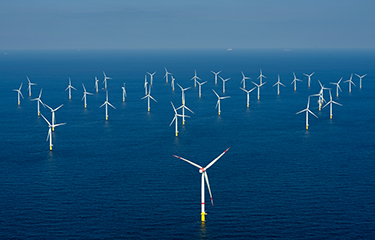Reports raise questions regarding impact of offshore wind on seafood industry

A pair of new reports from NOAA Fisheries’ Marine Fisheries Advisory Committee (MAFAC) and the Science Center for Marine Fisheries has raised more questions about how big offshore wind projects – planned for areas of water off the coast of New England in the Northeast U.S. – will impacts the fishing industry in the region.
The science center report calls into question the Bureau of Ocean Energy Management’s investigations of wind energy impacts on seafood, particularly the supplement to the draft environmental impact statement (SEIS) that the bureau released on June. That supplement was intended to examine all of the potential impacts wind energy development – both current and future – could have on the surrounding area.
That report, according to the science center, didn’t do enough to examine the impacts of wind energy on the fishing industry. The report highlighted eight key issues that the authors – which included Eric Powell, director of the Science Center for Marine Fisheries for the University of Southern Mississippi and Andrew Scheld, a fisheries economist for the Virginia Institute of Marine Science – identified as a failing of the SEIS.
“This table points out that the size and scale of what is being considered in the SEIS has not been studied to date and thus the existing literature under consideration in the SEIS may not adequately represent the situation in the U.S.,” the report states. “This issue is exemplified by the absence at the Mid-Atlantic scale of an evaluation of the basic siting plan for wind turbine field development. One does not know if the present profile is optimal in the sense of minimizing ecological and economic damage relative to cost and energy production potential. As a consequence, evaluation of the present plan must be conducted in a vacuum, when alternatives would provide important comparability.”
Among those issues is the “evaluation of the totality of impact across the Mid-Atlantic region,” in which the SEIS, according to the report, did not adequately examine projects with regards to the impact many different projects could have. While an individual wind project on its own could have minimal impact and would thus be approved, the cumulative effects of many different projects built near one another would be outside the scope of the examination.
Other key issues are lack of information on oceanographic processes and the influence wind turbines could have of flow around and through turbine fields, lack of consideration for the severity of climate change, adequacy of databases, a lack of examination of impacts on longer-lived species, potential impacts to fishing surveys and stock assessments, impacts on marine mammals that could result, and the economic impacts the project could have.
The science center's report came soon after another report by NOAA Fisheries that also identified potential concerns offshore wind could pose for the seafood industry. The report criticized the current pace of projects, which it says “is racing forward” without addressing critical issues.
“Meaningful outreach to stakeholders, directly or indirectly affected by wind farms on the outer continental shelf (OCS), is a critical requirement for planning these large-scale installations,” the MAFAC report states. “Web-based presentations, conference calls, and participation by BOEM in regional forums has not been sufficient to engage the varied stakeholder groups affected by offshore wind energy (OWE) projects. This has resulted in distrust and anger based on a perceived lack of transparency and input into the planning process.”
The report also mentioned that roughly 10 percent of the offshore shelf region of the Atlantic coast, from North Carolina to Massachusetts, is being considered for development, planning, and future leasing, highlighting the need for more thorough and consistent oversight.
The new reports echo many of the concerns of seafood industry stakeholders surrounding regions that have called for more investigation and input on the wind energy projects. Those concerns were aired to U.S. Interior Secretary David Bernhardt at a meeting on 21 July, where industry representatives asked for more input.
“The fishing industry has no seat at the table, and all we’re getting from our governors in those states, and also from the wind industry, is lip-service,” Lund’s Fisheries Inc. Owner Jeff Reichle told SeafoodSource after the meeting.
Bernhardt, too, criticized the BOEM report, calling it inadequate in the face of the rapid expansion of wind energy.
“It’s easy to come in 10 years later and say what people thought. Let me be very clear, BOEM did not, even in the initial draft of Vineyard, BOEM did not, in my opinion, adequately present the expansion they were going to see,” Bernhardt said. “They would say, 'Of course they didn’t,’ because they didn’t know it was going to happen.”
Photo courtesy of Tom Buysse/Shutterstock






Share